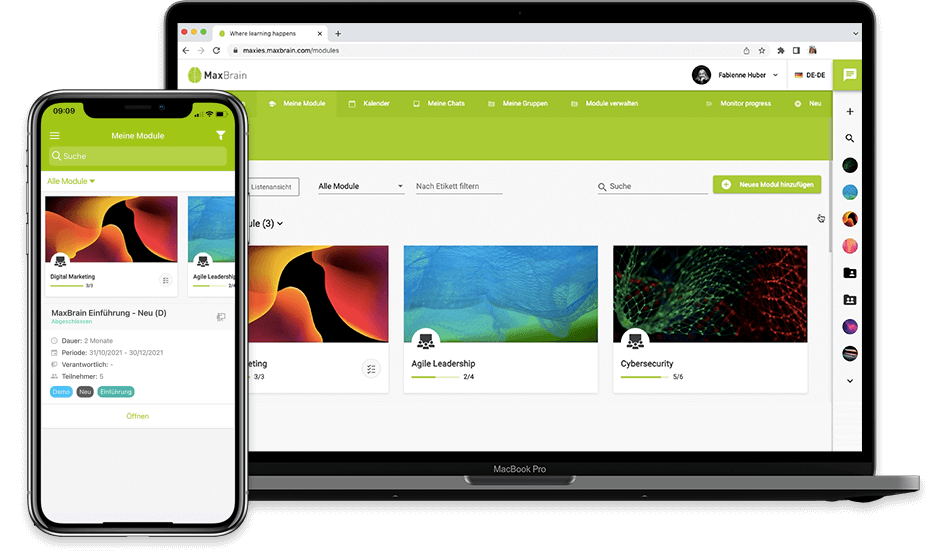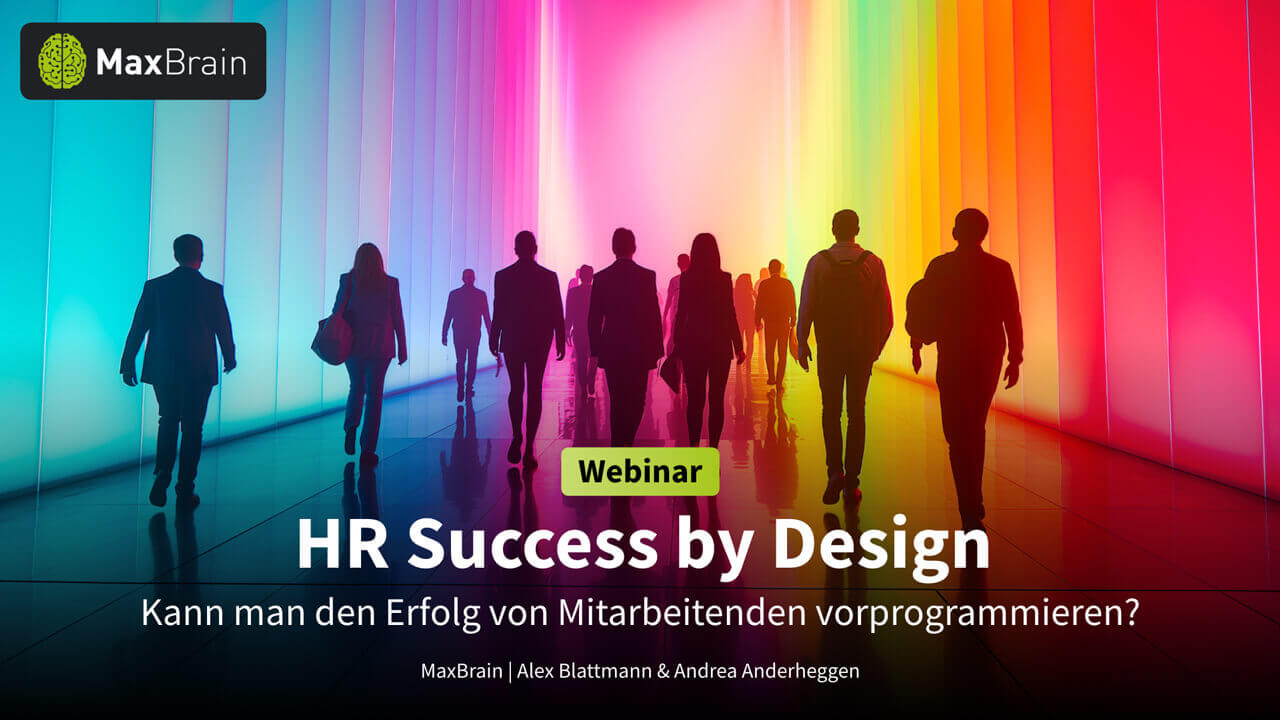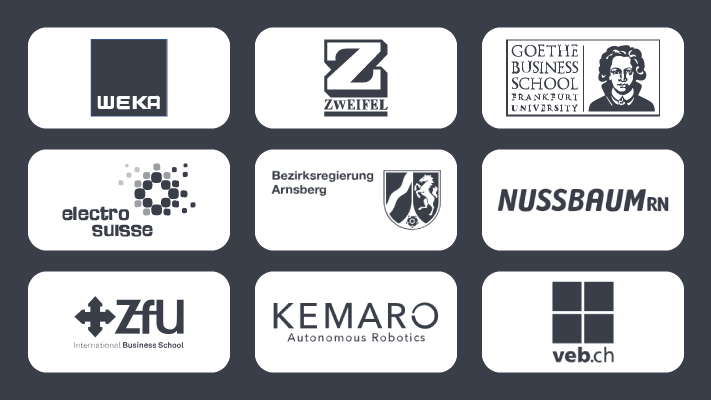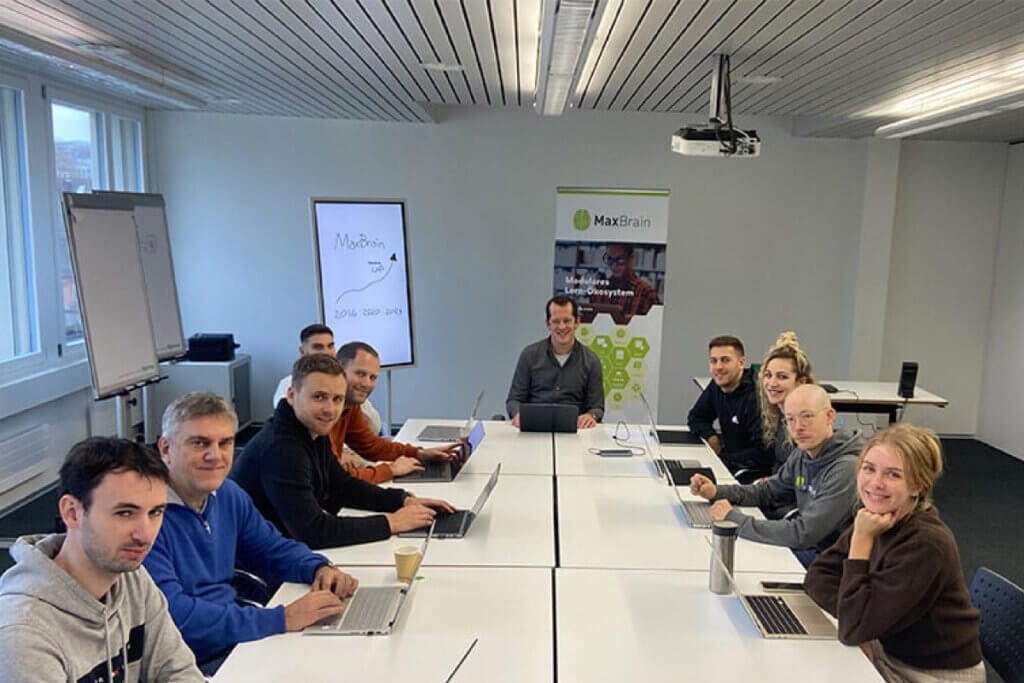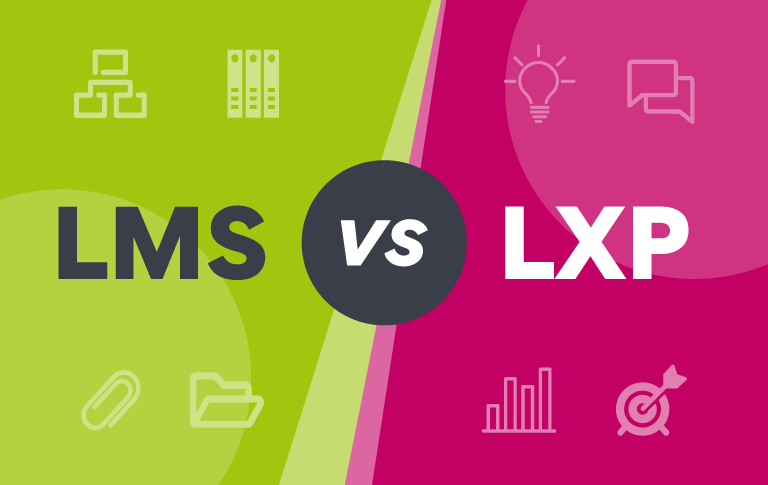Good LMS - checklist (summary)
In this article, we summarize what makes a good LMS. The most important points:
1. a good LMS helps to achieve specific goals of your company.
2 The user-friendliness of a learning platform is a basic requirement.
3. a good learning management system can be adapted to the look and feel of your company.
4 A comprehensive range of basic functions characterizes a good LMS.
5 A good LMS has the characteristics of an integration platform that can be used to connect existing or new technologies.
6 Every company has its own processes and priorities. A future-oriented LMS can be adapted to your own needs.
7 Providers of modern learning platforms are characterized by great innovative strength.
8 A good LMS makes no compromises when it comes to security and data protection.
9. providers of good learning platforms proactively help their customers to become successful. "Customer Success" is a fixed function, a department, at such providers.
10. a good LMS provides exciting, immediately applicable learning content via renowned third-party providers or in-house.
11 Modern learning management systems enable different forms of teaching: Pure online training and mixed forms such as blended learning.
12 Feedback and surveys are features that an LMS should offer to help teachers improve their teaching.
13 The possibility of collaboration between admins, teachers, managers and learners is more important than ever for a good LMS.
14 Mobile apps are a must for an LMS today, as learners spend around 70-80% of their time on mobile devices for private Internet use.
15 A good LMS is increasingly developing into a Learning Experience Platform (LXP). We have explained what this means in our blog article "LMS vs. LXP" has captured.
16 Learners like to spend a lot of time on exciting learning platforms. A good LMS therefore offers the opportunity to provide information about news and draw learners' attention to new offers. It offers additional functions for sales & marketing.
17 Return on investment: A good LMS leads to a lucrative cost-benefit ratio.
Learning platforms or learning management systems - "LMS" for short - have developed rapidly over time.
Just 5-10 years ago, the focus was mainly on rudimentary systems designed for short learning modules, exams and tests in an academic environment.
Today, not only training centers, but above all industrial companies use their own LMS as a decisive lever for growth.
The areas of application for learning platforms have multiplied: Training new employees, training specialist customers, retraining, further training for managers, salary training, quality assurance, knowledge transfer, marketing your own product range, holding online learning events and much more:
A modern LMS has long been much more than a simple learning system!
The Learning Management Systems industry, as a sub-sector of an even larger e-learning industry, has developed into a thriving industry in its own right. With more than 700 learning management systems available on the market worldwide today, organizations looking for an LMS are spoilt for choice.
In this article, I would like to discuss the criteria by which we at MaxBrain, as a provider of one of the leading LMSs in the German-speaking world, are regularly evaluated by customers and in comparison with our competitors.
They are the criteria that make the difference between cheap standard software in the short term and a solution that increases success in the long term.
A good LMS helps to achieve specific goals.
The first versions of learning management systems consisted of simple training videos and presentations provided by trainers. The aim was to teach someone something.
The modern LMS, on the other hand, has become an economic success factor in many places.
What does that mean?
It means that companies define specific goals to which a learning platform should make an indispensable contribution.
What are these goals?
There is no one-size-fits-all answer to this question. The goals are set by the decision-makers of an organization. A good LMS provider goes into these goals in depth and focuses on delivering the underlying KPIs (Key Performance Indicators) as results.
The most common goals that we encounter at MaxBrain and against which our own work is measured are usually:
- Increase in productivity
- More sales via business customers
- Marketing of news, products, courses, events
- Ensuring knowledge transfer
- Build employer branding
- Establishment of a learning culture
- Quality assurance in all areas of work
- Increase team motivation
A modern learning platform is intuitive and user-friendly.
User experience is a basic requirement for almost all LMS providers.
The tolerance threshold of modern users with regard to complicated systems is minimal: people lose their patience even at low levels of complexity and become indiscriminately annoyed by the entire offering.
How do you recognize a good user experience?
The answer is simple: by the fact that someone who doesn't know their way around immediately gets to grips with it.
An old saying goes:
A user interface is like a joke. If you have to explain it, it's not that good.
What does this mean in concrete terms for an LMS?
Only offer the features that are really needed and are self-explanatory.
Don't overwhelm learners and teachers with functions that they will never use.
Modern LMSs offer the possibility of switching features on and off precisely according to the needs of the organization.

Are you looking for a catalog of requirements for LMS providers?
A good LMS adapts to your corporate identity.
Companies are usually proud of their brand, and for good reason:
A brand tells a story and connects your company with a promise of quality, customer satisfaction or another value.
A brand helps employees to identify with their workplace.
To represent your company well, an LMS should be adaptable in terms of look and feel and never be perceived as a foreign body in your organization.
Specifically:
Custom colors, layout, logo, fonts, images, labels, terminology. - Details that make a Learning Management System your learning platform.
A good learning management system offers a comprehensive range of basic functions.
Of course, simple user interfaces and an aesthetic design adapted to your corporate identity alone are no guarantee of success.
Does your learning platform offer the functions and tools that learners expect, demand or find useful?
People today are mobile, impatient, communicative, visual or auditory, want to be entertained, see meaning in their work and gain recognition from colleagues. Always and everywhere.
A good LMS manages the balancing act between intuitive simplicity and far-reaching, user-oriented functions.
The minimum features of an LMS in terms of its functions are today:
- Course catalogs
- Content management system for courses
- Agenda
- Quizzes, tests & interactive elements
- Chats & integrations from Zoom, MS Teams etc.
- User Management
- Analytics & Dashboards
- Feedback tools
- Certificates
- Marketing functions for products, courses, events
- Sales-promoting features
- Mobile apps
A good LMS can be technically integrated with existing technologies and platforms.
As in many software industries, learning management systems were only developed as in-house solutions or in the open source model without cloud technologies around two decades ago - when internet connections were slow and mobile devices were just phones.
On the one hand, this had many disadvantages (e.g. costs and scalability), but it still shapes customer expectations today:
Most long-term oriented companies and training centers want a high degree of customization options that go beyond the rudimentary adaptation of "look and feel".
Adaptations are often expensive and time-consuming. In addition, attempts are made to develop features and functions that specialized technology providers have long since published much better and more successfully.
The solution:
A good LMS offers a wide range of integrations and integration options.
Innovative technologies are integrated via interfaces - also known as application programming interfaces, or "APIs" for short.
In the SaaS industry, the motto for a few years now has been: APIs are the basic prerequisite for successful SaaS companies.
When it comes to embedding an LMS in the existing system landscape, good LMS providers proceed at least as follows:
Step 1: Clear understanding of the solution and the value of the LMS within the existing systems.
Step 2: Development of a solution outline or a system design in which the LMS is seamlessly integrated into the business environment.
Step 3: Check with the company's IT department whether this solution can be implemented easily, quickly and cost-effectively.
Make sure that the LMS can be optimally connected to your existing systems.
Read more on TechCrunch: APIs are the next big SaaS wave
The most popular integrations relate to technologies that have reached the mass market, such as Zoom, Microsoft Teams, Slack, Surveymonkey and more.
A good e-learning platform can be adapted to your own objectives in the long term.
There is no patent remedy for a learning management system that suits all companies and training centers.
An organization can also change over time, define new goals, develop new markets and ideas: The LMS must be able to grow with it.
The requirements are often very different, dynamic and therefore require different functions within the established processes and to achieve the respective goals of a company.
A good LMS must therefore offer general customization options in addition to the possibility of integrations, so that companies can adapt it to their wishes; either themselves or via an experienced service provider.
Regular updates and innovation: the long-term requirement for a good LMS.
The learning industry is changing rapidly.
It is also not isolated from the rest of the world:
Digitalization, technologies, devices and user preferences are characterized by ever faster innovation cycles.
Personalization, artificial intelligence, recommendation marketing, new learning concepts and much more are changing the expectations of learners and offer exciting opportunities for companies that use a learning platform.
It is therefore crucial that the LMS evolves not only with your organization, but also with the market and long-term successful trends.
In-house developments or locally installed software have a clear disadvantage here: innovation suddenly becomes a job that is usually not part of a company's core competencies.
A good LMS does not compromise on security and data protection!
As with all Internet applications, security and data protection are also a basic requirement for a professional learning environment for learning platforms.
Good LMSs not only adhere to the requirements of the European General Data ProtectionRegulation (GDPR) and implement the latest IT security measures:
They are regularly tested by external auditors, follow the industry standards for information security and have an ISO 27001 certificate.
Customer care and customer success: A good LMS is not a system, but a solution.
Companies want to use an LMS to solve one or more problems in line with their objectives.
A good LMS provider focuses not only on providing a powerful platform, but also on achieving the customer's goals as well as possible.
The solution to a problem sometimes goes beyond the possibilities of software: personal communication and support from an employee of the LMS provider is then required.
When choosing an LMS, pay attention to whether an LMS provider has a dedicated customer success team and what the service offering looks like in detail.
The best customer success teams are those that not only solve their customers' problems and answer their questions, but also proactively make recommendations to improve the learning experience and better achieve the company's goals.

A good LMS offers existing general courses and services for the creation of individual learning content.
A learning platform without learning content is at best a framework without content, without life.
From the user's point of view, learning content determines whether a learning platform is accepted or not. Education content must be new, exciting, clear, understandable, entertaining and motivating.
Learners do not differentiate between technology and its application. - If the learning content is boring or uninspired, the entire learning platform is criticized across the board - no matter how great the technology, innovation, design or user guidance are.
A good LMS therefore offers solutions for learning content that inspires and promises a high level of learner engagement. Learning content can be produced in-house or purchased externally.
Online learning also offers an exciting opportunity:
The personalization.
No learner is the same, so why shouldn't this apply to individual training?
Thanks to automated, intelligent data processing, very good LMSs can recommend individual courses to learners that exactly match a person's level of knowledge.
Personalization can take many forms, but in any case, it allows users to focus on the areas they need to improve the most instead of wasting time repeating information they already know.
The ability to create personalized learning paths is a useful feature for creating engaging, customizable courses.
More about learning content: Learning content at MaxBrain
A good LMS supports blended learning formats.
Blended learning, also known as hybrid learning, is an educational approach in which web-based courses are combined with traditional, location-based teaching methods and teachers.
Learners benefit from the advantages of both worlds: Flexible e-learning and face-to-face teaching.
A good LMS offers the opportunity to implement these modern forms of teaching: The freedom to follow individual learning paths is combined with the opportunity for teachers to communicate specifically with learners, understand progress and help where there are gaps in knowledge.
Feedback features: A good LMS should help to regularly optimize courses.
Course quality is crucial for learner acceptance and progress.
The best learning management systems therefore offer functions that allow courses to be optimized as specifically as possible.
An important element here:
The feedback function, i.e. the opportunity for learners to evaluate courses and make suggestions on how courses and teaching methods could be improved.
Make sure that an LMS either offers survey functions out of the box or - even better - provides seamlessly embedded integrations to tools such as SurveyMonkey or GoogleForms.
You can see the integration of SurveyMonkey using the example of MaxBrain here:
A good LMS enables all participants to collaborate on the learning platform.
The trend today is as clear as it is long-term: collaborative work tools such as Google Drive, Figma and Slack dominate the day-to-day work of many companies.
Who wants to send documents back and forth by email when you can collaborate directly and in real time on a platform?
A good LMS should offer course administrators, teachers and learners the opportunity to work collaboratively and therefore efficiently in the learning environment.
Integrated online chats, discussion forums, group functions, access to online learning content and much more make the difference here between an extremely fast and a labor-intensive learning management system.
The learning platform as a mobile app corresponds to today's way of life.
It's no longer a secret: the vast majority of Internet use takes place on mobile devices, not on desktop computers. The smartphone is a constant and indispensable companion for many people.
It is therefore hardly surprising that more and more learners want to access learning content via their smartphones while on the move.
Learners expect a fully functional LMS experience on mobile devices and like to be surprised by useful, mobile-only features.
Locally installable mobile apps are particularly useful here: they combine speed, simple user guidance and a permanent local presence of course providers on the learner's home screen.
Thanks to apps, companies can reach their learners quickly and directly via push messages, offer mobile-optimized learning aids and much more.
Good LMSs therefore always offer the option of mirroring the learning environment on individual mobile apps and supplementing it in a meaningful way.
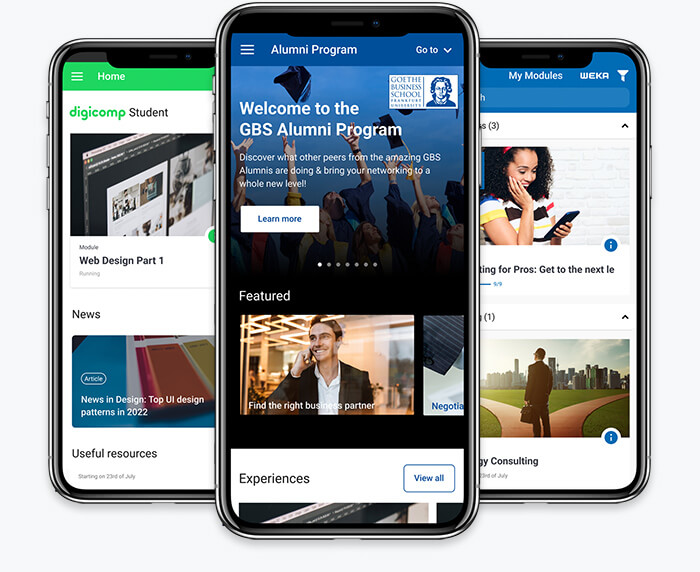
Dashboard and analytics for better achievement of set goals.
"Without data, you're just another person with an opinion."
W. Edwards Deming
As mentioned at the beginning, concrete objectives are the starting point for every decision for or against an LMS.
However, goals make little sense if you don't measure how well you achieve them later on. A good LMS enables the individual measurement of key performance indicators (KPIs) and success-relevant metrics.
Aside from individual goals, data and analytics are hugely important for any learning environment:
To better understand learner progress and engagement, identify the best courses, identify knowledge gaps, etc.
A good LMS offers clear dashboards and analysis options to ensure both individual KPIs and general insights into the functioning of the learning environment.
A good LMS is developing into a Learning Experience Platform (LXP).
E-learning has been undergoing a paradigm shift for some years now: learning in companies is becoming increasingly learner-centered.
The (good) Learning Management System (LMS) is therefore increasingly developing into a Learning Experience Platform (LXP).
Personalized learning content and learning paths are among the key functions of an LXP.
Personalization means that data analysis and artificial intelligence are increasingly being used to derive learning objectives from learning measures and recommend course modules or further training programmes, depending on the individual learning progress and preferences of a learner.
The development of artificial intelligence for learning environments is still in its infancy in many places.
However, cloud-based software-as-a-service (SaaS) providers have many advantages over locally installed, on-premise software solutions: They can collect data across companies and utilize it in such a way that it benefits the entire customer base of an LMS. SaaS providers therefore have the best prerequisites for learning with the market and the users themselves.
Therefore, make sure that your LMS provider has a "community" of customers who share their experiences with the LMS provider or with each other and who allow the LMS provider to offer a long-term leading solution.
Good LMSs perform as a marketing and sales channel.
A good LMS inspires learners and is therefore used frequently:
On our own MaxBrain learning platform, we see that learners log in at least 8 times per course day on average.
There are a number of companies that record hundreds of logins and thousands of page views for each individual learner.
In marketing language:
An LMS offers many touchpoints to reach users.
What does that mean in business terms?
It means that an LMS can be used very effectively to promote products, services, events, company values and much more. Examples:
a. Commercial training centers can advertise their course offerings and generate up- and cross-selling revenue.
b. Industrial companies can train specialist customers and combine further training directly with the promotion and sale of products.
c. Companies can advertise company events, trade fairs, webinars and much more.
An LMS can suddenly become a sales-relevant platform.
The following video shows how an LMS becomes a marketing channel, using MaxBrain as an example:
A good LMS is offered at a lucrative cost-benefit ratio.
The bottom line is that for profit-oriented companies, the cost-benefit ratio is of course important when evaluating an LMS.
But:
Benefits and costs are often not so easy to determine:
The benefits depend largely on whether a learning platform supports your organization in achieving the above-mentioned goals. The question of benefit can often only be answered individually.
After countless discussions with customers, I can confirm that many companies are unable to fully assess the opportunities and therefore the benefits of a learning platform. This is often due to the fact that learning is not seen as a far-reaching business-relevant factor and the objectives are therefore only set in a limited commercial sense.
A frequently seen example:
The head of the HR department of a large industrial company is looking for a learning platform to accelerate productivity - for example, the training of new employees - and make it more scalable. This goal makes perfect sense from the perspective of an HR manager and is in line with her personal objectives.
In a broader business context, however, the learning platform could also train specialist partners and representatives. Learning would suddenly serve as a starting point for exciting marketing opportunities and ultimately even sales growth. - The learning platform as a sales channel!
However, this idea is outside the area of responsibility of an HR manager and should rather be discussed with the marketing manager or the managing director, who are responsible for sales development.
The full potential - the benefit - of an LMS is often only recognized in part.
When evaluating costs, it is often difficult to consider the full costs because only the license prices are taken into account, not the follow-up costs and even less the opportunity costs.
Although the costs of an LMS are easier to compare across companies, they also contain a number of pitfalls that are easily overlooked by the layman.
For example, open source software often sounds much cheaper than comparable cloud-based software-as-a-service platforms. This is because the low one-off license costs of software can quickly give the impression that the annually recurring costs of a cloud-based solution are unattractive.
However, open source solutions could end up being very expensive. This is because the license costs are often just the tip of the iceberg.
As soon as in a full cost calculation In addition to the license costs of a software, the costs for maintenance, updates, development work, training, administration, security updates, data protection, scaling, mobile accessibility, etc. are also taken into account, solutions that were initially "cheap" suddenly become very expensive.
Modern, cloud-based SaaS solutions can be full cost consideration on the other hand, can be much cheaper despite their annually or monthly recurring license costs. This is because the entire, at first glance unrecognizable cost block that results from the long-term use of open source software is simply eliminated.
One last point:
There are costs of low-cost solutions that are very difficult to calculate at all: Opportunity costs.
Once again applied to the above example:
If you only use a learning platform to train new employees, you miss the opportunity to use the learning platform as a marketing and sales channel - an opportunity that is particularly relevant to sales for industrial companies.
What does this reduced use of a learning platform cost?
Nothing on paper. -
Compared to the full potential of a learning platform as a marketing and sales channel, this could be hundreds of thousands or millions of euros.
Sometimes cheaper is not automatically better.


Are you looking for a catalog of requirements for LMS providers?
Did you like this article?
If so, please share this article on your social media channels. Thank you very much!
